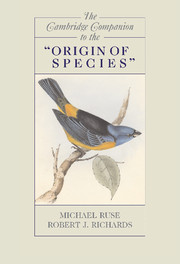Book contents
- Frontmatter
- Foreword
- Introduction
- 1 The Origin of the Origin
- 2 Darwin’s Analogy between Artificial and Natural Selection in the Origin of Species
- 3 Variation and Inheritance
- 4 Darwin’s Theory of Natural Selection and Its Moral Purpose
- 5 Originating Species: Darwin on the Species Problem
- 6 Darwin’s Keystone: The Principle of Divergence
- 7 Darwin’s Difficulties
- 8 Darwin’s Geology and Perspective on the Fossil Record
- 9 Geographical Distribution in the Origin of Species
- 10 Classification in Darwin’s Origin
- 11 Embryology and Morphology
- 12 Darwin’s Botany in the Origin of Species
- 13 The Rhetoric of the Origin of Species
- 14 “Laws impressed on matter by the Creator”? The Origin and the Question of Religion
- 15 Lineal Descendants: The Origin’s Literary Progeny
- 16 The Origin and Political Thought: From Liberalism to Marxism
- 17 The Origin and Philosophy
- 18 The Origin of Species as a Book
- Bibliography
- Index
12 - Darwin’s Botany in the Origin of Species
Published online by Cambridge University Press: 28 January 2009
- Frontmatter
- Foreword
- Introduction
- 1 The Origin of the Origin
- 2 Darwin’s Analogy between Artificial and Natural Selection in the Origin of Species
- 3 Variation and Inheritance
- 4 Darwin’s Theory of Natural Selection and Its Moral Purpose
- 5 Originating Species: Darwin on the Species Problem
- 6 Darwin’s Keystone: The Principle of Divergence
- 7 Darwin’s Difficulties
- 8 Darwin’s Geology and Perspective on the Fossil Record
- 9 Geographical Distribution in the Origin of Species
- 10 Classification in Darwin’s Origin
- 11 Embryology and Morphology
- 12 Darwin’s Botany in the Origin of Species
- 13 The Rhetoric of the Origin of Species
- 14 “Laws impressed on matter by the Creator”? The Origin and the Question of Religion
- 15 Lineal Descendants: The Origin’s Literary Progeny
- 16 The Origin and Political Thought: From Liberalism to Marxism
- 17 The Origin and Philosophy
- 18 The Origin of Species as a Book
- Bibliography
- Index
Summary
He moons about in the garden, and I have seen him standing doing nothing before a flower for ten minutes at a time. If he only had something to do, I really believe he would be better.
- Charles Darwin’s gardenerDARWIN’S BOTANY: INTRODUCTION
Taxon-based studies defined much of natural history in the nineteenth century, with botany and zoology serving as the two major realms of such inquiry. Darwin himself was taxonomically promiscuous, flitting from organism to organism much as his curiosity dictated but also out of a utilitarian need for particular examples to support a generalizable theory that explained the diversity of living organisms. Thus, in the course of his scientific career Darwin studied a range of organisms and familiarized himself with related sciences like geography and geology. But increasingly after the Origin, his lifelong interest in botany not only revealed itself but came to dominate his research.
That interest had started early. In fact, one could say that he inherited it; his grandfather Erasmus was a translator of Linnaeus, while another relative, John Wedgewood, was one of the founders of the Royal Horticultural Society. Almost serving as a prophetic image of the role that botany would play in his life, an early portrait of the young Charles shows him seated next to his sister Catherine holding a pot of plants.
- Type
- Chapter
- Information
- The Cambridge Companion to the 'Origin of Species' , pp. 216 - 236Publisher: Cambridge University PressPrint publication year: 2008
- 1
- Cited by



